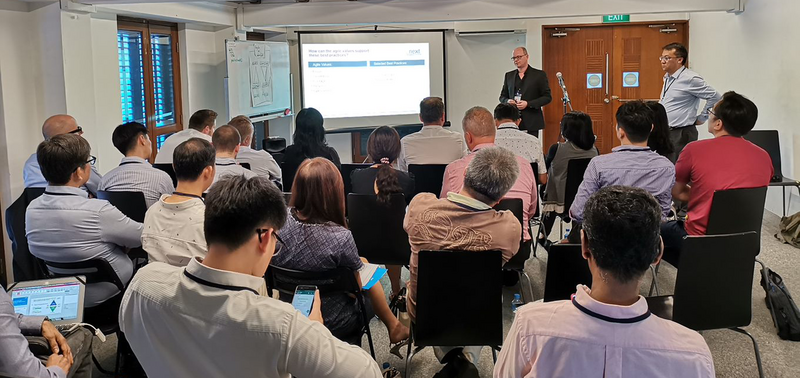
11.04.2019 | Press
Report from the next level of agility conference in Singapore
On March 27 we brought together more than 80 of our customers, partners and consultants in Singapore to explore how to scale agility from projects to the organization. Supported by our global team of agile consultants our CEO Wolfgang Rabl and APAC team shared experiences, approaches, and case studies from a wide range of topics covering vision, culture, leadership, governance and project management best practices in interactive presentations, workshops and discussions.
Most participants agreed that their internal rate of change is not sufficiently matching the external rate of change and see a journey to higher agility as a necessity to ensure the survival of their organizations.
As Wolfgang Rabl, CEO of next level consulting, puts it: “There are many approaches to managing complexity and dynamics. The old ways of working like processes and temporary project organizations are not obsolete and need to be combined with the new agile ways of working in the most effective way. Often, adopting such a hybrid approach is more efficient and faster to implement than going 100% agile.”
Agility succeeds bottom-up but completes top-town. Most participants have started to pilot and experiment with agility in projects, see its value and are ready to scale it into other parts of the business. Yet, they are facing issues that require a more comprehensive top-down approach.
As Thomas Martin, Managing Director APAC, puts it: “You need to start with a clear understanding and vision about what agility is and what it can do for you. Then you need start to own it and find your own individual agility. It is not about what the text books say or what your competitor does. It’s about what works best for you, what suits your own culture and people best.”
Establishing an agile mindset and culture was seen as pivotal for beginning an agile journey. Merissa Madani, culture expert and Senior Consultant with next level consulting APAC advises: “In a traditional organization, culture is often implicit and not actively shaped. This is acceptable when hierarchies, roles and bureaucracy provide the necessary structure to execute successfully. In an agile organization, these old structures often cause inflexibility and need to be scaled back. This requires culture to step-up to become the new unifying binding element that keeps the organization together. Moving to an explicit, active and lived culture is critical for achieve higher levels of agility.”
An actively lived agile culture with a clear set of shared values is only the starting point, It needs leadership to put it into action. Adopting a servant agile leadership style was seen as equally important to translate explicit and actively lived agile values into the right behaviours. As Sanjay Mehta, leadership coach and Senior Consultant at next level consulting puts it: “Transforming middle managers to front-line leaders is a major challenge in most organizations and benefits from strong executive sponsorship, professional change management and external coaching.”
In moving from vision to culture and leadership the conference established the top-down view of how to go after an agile transformation. In a parallel stream we explored hand-on experiences and approaches starting with best practices for agile project management.
Many agile project practices like daily stand-ups, sprints, and retrospectives used in agile projects can be easily adopted in agile teams in other parts of the organization. As Walter Sedlacek, agile project management expert and APAC Managing Director at next level consulting, puts it: “understanding the different agile methodologies and frameworks enables you to combine them into an individual set of practices that best serves the needs of your project and line teams.”
Experimenting with agile practices to learn, adapt, and combine them to form your individual agile toolset bottom-up is the most common starting point for an agile transformation across all next level consulting clients.
The implementation of agile practices benefits from supportive team building activities that were explored in an additional session lead by Krish Iyer, a next level consulting partner from Qua Aliter Associates. He advises: “Agile teams are self-organizing and autonomous. Their formation is the responsibility of the team members and benefits strongly from external coaches. The successes and scaling of agile teams is contingent upon leadership creating the essential and enabling conditions.”
As more and more teams in an organization start working agile, independently drive customer satisfaction and business results a new issue starts to become apparent: the need for coordination. Traditional organizations with top-down execution often suffer from strategy execution failure. Agile organizations with efficient bottom-up execution may experience execution strategy failure: How do you coordinate all those globally dispersed, self-organized and autonomous teams that do great individually to jointly execute against the organizational purpose, vision, and strategy? This topic was explored in our session about agile governance. Thomas Martin, Managing Director APAC, advises: “To get started with agile governance, leverage your agile coaches and sponsors that work with your teams on a daily basis and implement communities of practice or guilds to give them a platform to identify, discuss and resolve inter-team coordination and resourcing issues.”
The conference concluded with a panel discussion about building hybrid organizations. The discussion confirmed that every organization needs to find its individual approach to agility. It also became clear that starting on an agile journey does not require long and complex planning. Instead, you start agility with being agile: Identify a good place to get started, and simply do it.
After the conference the participants gathered in the court yard of the beautiful Malay-heritage bungalow under the sinking sun of a warm tropical day enjoying Western and Asian food and Austrian wine.
